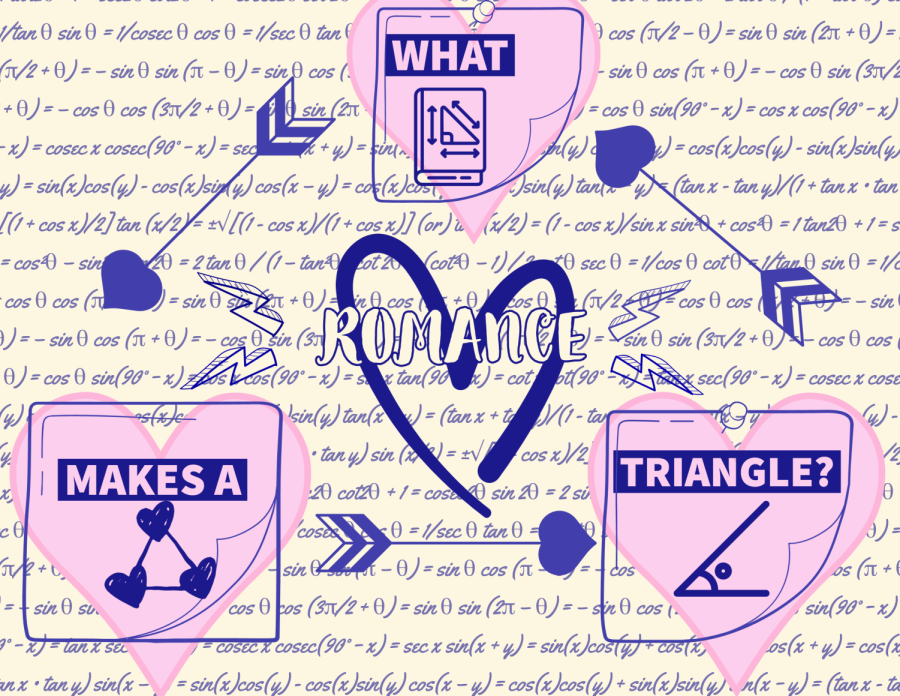Trigonometry of love
The trope to end all tropes: the love triangle. You either love it, or you hate it. But perhaps it’s time to look at this cliché from another angle.
Using the same algorithm will always get you the same result that people are tired of seeing.
A necessary evil for what is arguably one of the most popular genres of entertainment out there: romance. You’ve seen the movies. You’ve read the books. Maybe you’ve even witnessed it in real life. It’s the same formula, over and over again, and always produces the same results. The love triangle has been a staple in storytelling ever since the beginning of time— a guilty-pleasure trope people can’t help but indulge in every once in a while.
They say three’s a crowd, and it’s clear that many would agree. For too long, this trope has taken over the majority of love stories, used as a cheap trick to create a source of conflict or as a way to stir up more drama before entering the third act of the story, and people are sick of it. Sick of infidelity, protagonists being indecisive, second leads being tossed away like trash, love interests being the peak of average, everything. So why is it that these stories continue to pop up on our screens? What about this trope has writers treating it like a security blanket, holding on tightly and refusing to let go?
Here’s the truth: love triangles aren’t the problem; bad writing is. Decades of reusing the same algorithm and redoing the same plotlines because that’s what Hollywood thinks people enjoy is a miscalculation that’s ruining the romance genre. Love triangles are supposed to be a tool to help move the story along, not make up the story entirely or used as a subplot that contributes no substance at all. It’s a lazy shortcut that makes up for the lack of chemistry, and fans of the genre can see it coming from a mile away. Half the time, it seems that writers can’t even recall the original purpose of the most romantic shape in the book.
The reason for including the love triangle is something often misinterpreted, and making this vital mistake can make or break the entire story. What often occurs is that our main lead finds themselves stuck between two characters who are in equal pursuit of their affection— usually, a relationship has already been established between one of the two love interests— and by the climax of the story, the protagonists realize who their true feelings are for and makes a show of choosing who their soulmate will be.
Already there’s a huge flaw: if the main lead is in a confirmed relationship with a love interest in the first place, then it doesn’t matter who they end up with in the end; the outcome will be less than welcome. On one hand, choosing their current partner means they have to live with the knowledge that, at some point, they grew feelings for someone else when they were still in a relationship. Tough. However, going with the other person means that they had to leave someone who genuinely loved them, and it feels wrong to be happy for the new couple.
Well-written love triangles don’t test the relationship or create unnecessary tension; they’re supposed to demonstrate that love can come in different forms. It shows that love is surprising. Unexpected. Never what you think it is. People express love in different ways and having multiple love interests in a story should be about exploring which ways are most compatible with each other.
Why not change things up a bit? Anyone who’s ever sat through any remedial math class knows there’s not just one type of triangle. There’s equilateral, isosceles, acute… give me variety! There is more than one way to construct the shape. The current love triangle we use now only goes in one direction: Guy-> Girl <-Guy. That’s hardly a triangle. It’s a corner. Now, it’s a very fine corner, of course, but we send people to the corner as punishment for a reason. Love should be freeing, not push them into a corner.
How about romantic rivals into lovers? Two people fighting for the affection of an outside party, only to fall for each other instead. Can you imagine the drama? That still maintains a triangular shape. Or a trio of people who all love each other in some way but ultimately know that only one pair can prevail. Guy #1 likes Girl, who likes Guy #2, who has unreciprocated(?) feelings for Guy #1, and no one is attracted to just one person. Messy, but relationships are sometimes like that. No one ever said that the sides to a love triangle always had to be “straight,” anyhow. And besides, why should there only be one pair? I hear polyamory is very in right now. Triangles can have different lengths and angles which can change how they look, but they’re still the same shape.
2+2=4. That’s the equation but not the only way to the answer. There’s also 1+3, 6-2, 2.5+1.5, 16/4, etc,. The classic love triangle is a format that is going out of style. That doesn’t mean we have to throw the entire practice out of the window, though. Use a different angle, find a different variable; you can’t just sum up the concept of love in a single equation!
Your donation will support the student journalists of West High School. Your contribution will allow us to purchase Scholarship Yearbooks, newsroom equipment and cover our annual website hosting costs.

(she/her) Nicole is a senior and in her third year on staff and second year as opinion editor. You can usually spot her walking down the hall wearing her...



